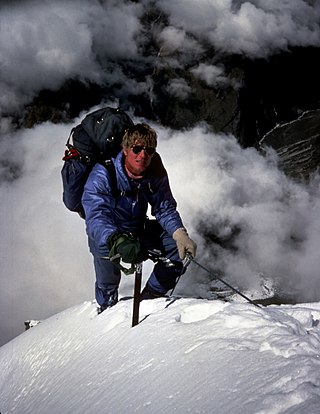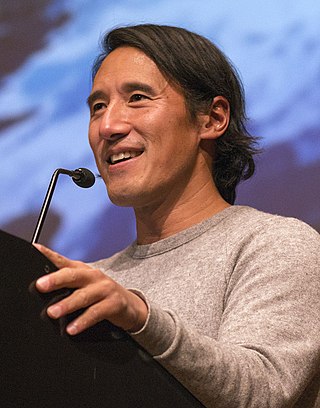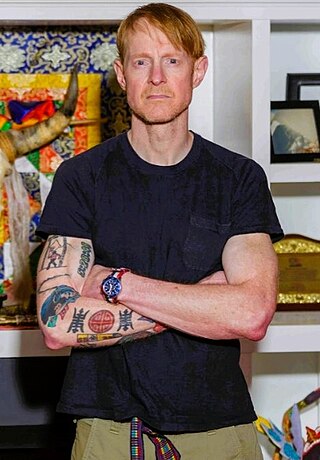
K2, at 8,611 metres (28,251 ft) above sea level, is the second-highest mountain on Earth, after Mount Everest at 8,849 metres (29,032 ft). It lies in the Karakoram range, partially in the Gilgit-Baltistan region of Pakistan-administered Kashmir and partially in the China-administered Trans-Karakoram Tract in the Taxkorgan Tajik Autonomous County of Xinjiang.
Jim Wickwire is the first American to summit K2, the second highest mountain in the world. Wickwire is also known for surviving an overnight solo bivouac on K2 at an elevation above 27,000 ft or 8,200 m; considered "one of the most notorious bivouacs in mountaineering history".
The Seven Summits are the highest mountains on each of the seven traditional continents. Reaching the peak of these summits is considered a significant achievement amongst many mountaineers, alongside many other such goals and challenges in the mountaineering community. On 30 April 1985, Richard Bass became the first climber to reach the summit of all seven.

Scott Eugene Fischer was an American mountaineer and mountain guide. He was renowned for his ascents of the world's highest mountains made without the use of supplemental oxygen. Fischer and Wally Berg were the first Americans to summit Lhotse, the world's fourth highest peak. Fischer, Charley Mace, and Ed Viesturs summitted K2 without supplemental oxygen. Fischer first climbed Mount Everest in 1994 and later died during the 1996 blizzard on Everest while descending from the peak.

David Finlay Breashears is an American mountaineer, filmmaker, author, and motivational speaker. In 1985, he reached the summit of Mount Everest a second time, becoming the first American to reach the summit of Mount Everest more than once. He is perhaps best known as the director and cinematographer of Everest (1998)—which became the highest-grossing IMAX documentary—and for his assistance in the rescue efforts during the 1996 Everest disaster, which occurred during the film's production.

Alan Hinkes OBE is an English Himalayan high-altitude mountaineer from Northallerton in North Yorkshire. He is the first British mountaineer to claim all 14 Himalayan eight-thousanders, which he did on 30 May 2005.

Edmund Viesturs is an American high-altitude mountaineer, corporate speaker, and well known author in the mountain climbing community. He was the first American climber to ascend all 14 of the eight-thousander mountains, and the 5th person to do so without supplemental oxygen. Along with Apa Sherpa, he has summitted eight-thousanders on 21 occasions, including Mount Everest seven times.

Eric Earle Shipton, CBE, was an English Himalayan mountaineer.
Tim Macartney-Snape is an Australian mountaineer and author. On 3 October 1984 Macartney-Snape and Greg Mortimer were the first Australians to reach the summit of Mount Everest. They reached the summit, climbing without supplementary oxygen, via a new route on the North Face. In 1990, Macartney-Snape became the first person to walk and climb from sea level to the top of Mount Everest. Macartney-Snape is also the co-founder of the Sea to Summit range of outdoor and adventure gear and accessories, a guide for adventure travel company World Expeditions and a founding director and patron of the World Transformation Movement.

The Kangshung Face or East Face is the eastern-facing side of Mount Everest, one of the Tibetan sides of the mountain. It is 3,350 metres (11,000 ft) from its base on the Kangshung Glacier to the summit. It is a broad face, topped on the right by the upper Northeast Ridge, and on the left by the Southeast Ridge and the South Col. Most of the upper part of the face is composed of hanging glaciers, while the lower part consists of steep rock buttresses with couloirs between them. The steep southern third of the Kangshung Face also comprises the Northeastern Face of Lhotse; this section may be considered a separate face altogether following the division of the South "Neverest" Buttress up to the South Col. It is considered a dangerous route of ascent, compared to the standard North Col and South Col routes, and it is the most remote face of the mountain, with a longer approach.

Conrad Anker is an American rock climber, mountaineer, and author. He was the team leader of The North Face climbing team for 26 years until 2018. In 1999, he located George Mallory's body on Everest as a member of a search team looking for the remains of the British climber. Anker had a heart attack in 2016 during an attempted ascent of Lunag Ri with David Lama. He was flown via helicopter to Kathmandu where he underwent emergent coronary angioplasty with a stent placed in his proximal left anterior descending artery. Afterwards he retired from high altitude mountaineering, but otherwise he continues his work. He lives in Bozeman, Montana.

Louis French Reichardt is a noted American neuroscientist and mountaineer, the first American to summit both Everest and K2. He was also director of the Simons Foundation Autism Research Initiative, the largest non-federal supporter of scientific research into autism spectrum disorders and is an emeritus professor of physiology and biochemistry/biophysics at UCSF, where he studied neuroscience. The character of Harold Jameson, U.C.S.F. biophysicist and mountaineer in the film K2, is based on Reichardt, though the events of his actual 1978 K2 attempt with Jim Wickwire bear little resemblance to the plot of the film.

Jimmy Chin is an American professional mountain athlete, photographer, skier, film director, and author.
John Roskelley is an American mountain climber and author. He made first ascents and notable ascents of 7,000-meter and 8,000-meter peaks in Nepal, India, and Pakistan. In 2014, he became the 6th winner of the Piolet d'Or Lifetime Achievement Award.

Alison Levine is an American mountain climber, motivational speaker and leadership consultant. She is the author of On the Edge: The Art of High Impact Leadership and the executive producer of a documentary, The Glass Ceiling. She has ascended the highest peaks on every continent and also skied to both the North and South Poles. In 2010, she completed the Adventure Grand Slam by reaching the summit of Mount Everest.
Rodrigo Jordán Fuchs is a Chilean business man, a University Professor, social entrepreneur and mountaineer. He is a founder and president of Vertical S.A., Leadership Professor in Pontifical Catholic University of Chile’s MBA (MBA-UC) and Faculty member of Executive Education at the Wharton School of Business of the University of Pennsylvania. Since 2018, he is also president of the Comunidad de Organizaciones Solidarias. Considered an accomplished mountaineer, he led the first South-American expedition to summit Everest in 1992. He repeated the ascent in 2012 and 2016 by different routes, making him the only person to have summited Mount Everest on each of its faces. He has also been in many expeditions on mountains around the world and has authored a series of books and documentary films that recount these adventures.

Garrett Madison is an American mountaineer, guide and expedition leader. Madison began guiding professionally in 1999 on Mount Rainier and has reached the summit of Mount Everest 13 times. His company, Madison Mountaineering, specializes in climbs on Mount Everest and other high altitude peaks, operates on the highest peaks on all seven continents, and also provides training programs and summit climbs in Washington State.

Sean Burch is an American explorer, mountaineer, Leadership, Wellness, and Executive Performance Specialist, and documentary filmmaker. He is the author of the book, Hyperfitness: 12 Weeks to Reaching Your Inner Everest and Getting into the Best Shape of Your Life . He holds 8 World Records within fitness and adventure, and was the winner of National Geographic Channel’s Ultimate Survival Alaska TV show. Burch is the creator and founder of Hyperfitness, a wellness program. He was named Goodwill Ambassador to Nepal by the country's government. He resides within the Washington DC area.














